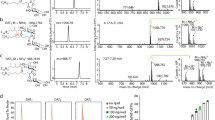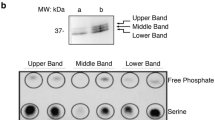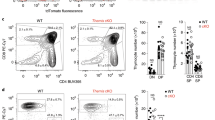Abstract
A NUMBER of lymphocyte surface proteins are anchored in the cell membrane by glycophosphatidyl inositol (known as GPI) linkages instead of hydrophobic protein domains1,2. Treatment of mouse T lymphocytes with antibodies specific for two such proteins, Thy-1 and Ly-6, are known to induce proliferation3,4. We have found that antibodies specific for Qa-2, a GPI-anchored class I histocompatibility antigen5, can also activate mouse T cells. To determine whether the GPI-anchor is important for this pathway of cell activation, we produced transgenic mice expressing either normal GPI-anchored Qa-2, or Qa-2 molecules with a membrane-spanning protein domain derived from H–2. Our studies show that only lymphocytes from transgenic mice carrying GPI-anchored forms of Qa-2 can be activated in vitro by Qa-2-specific antibodies. We also show that transgenic mouse T cells expressing a GPI-anchored form of H-2Db can be activated by anti-H-2Db anti-bodies. These results strongly indicate that the GPI-anchor is critical for this pathway of T cell activation.
This is a preview of subscription content, access via your institution
Access options
Subscribe to this journal
Receive 51 print issues and online access
$199.00 per year
only $3.90 per issue
Buy this article
- Purchase on Springer Link
- Instant access to full article PDF
Prices may be subject to local taxes which are calculated during checkout
Similar content being viewed by others
References
Low, M. Biochem. J. 244, 1–13 (1987).
Ferguson, M. A. J. & Williams, A. F. A. Rev. Biochem. 57, 285–320 (1988).
Kroczek, R. A., Gunther, K. C., Seligmann, B. & Shevach, E. M. J. Immun. 136, 4379–4384 (1986).
Yeh, E. T. H., Reiser, H., Daley, J. & Rock, K. L. J. Immun. 138, 91–97 (1987).
Stiernberg, J., Low, M. G., Flaherty, L., & Kincade, P. W. J. Immun. 138, 3877–3884 (1987).
Ledbetter, J. D. et al. Eur. J. Immun. 18, 1601–1608 (1988).
Van Wauwe, J. P., De May, J. R. & Goossens, J. G. J. Immun. 124, 2708–2713 (1980).
Hara, T., Fu, S. M. & Hansen, J. A. J. exp. Med. 161, 1513–1524 (1985).
He, Q., Beyers, A. D., Barclay, A. N. & Williams, A. F. Cell 54, 979–984 (1988).
Gunther, K. C. et al. Nature 326, 505–507 (1987).
Robinson, P. J. & Spencer, S. C. Immun. Lett. 19, 85–94 (1988).
Flaherty, L. Immunogenetics 3, 533–539 (1976).
Waneck, G. L., Sherman, D. H., Calvin, S., Allen, H. & Flavell, R. A. J. exp. Med. 165, 1358–1370 (1987).
Mellor, A. L., Antoniou, J. & Robinson, P. J. Proc. natn. Acad Sci. U.S.A. 82, 5920–5924 (1985).
Devlin, J. J., Weiss, E. H., Paulson, M. & Flavell, R. A. EMBO J. 4, 3203–3207 (1985).
Dobberstein, B., Garoff, H., Warren, G. & Robinson, P. Cell 17, 759–769 (1979).
Waneck, G. L., Stein, M. E. & Flavell, R. A. Science 241, 697–699 (1988).
Lemke, H., Hämmerling, G. J. & Hämmerling, U. Immunol. Rev. 47, 175–206 (1979).
Yeh, E. T. H., Reiser, H., Bamezai, A. & Rock, K. L. Cell 62, 665–674 (1988).
Weiss, E. H., et al. Nature 310, 650–655 (1984).
Author information
Authors and Affiliations
Rights and permissions
About this article
Cite this article
Robinson, P., Millrain, M., Antoniou, J. et al. A glycophospholipid anchor is required for Qa-2-mediated T cell activation. Nature 342, 85–87 (1989). https://doi.org/10.1038/342085a0
Received:
Accepted:
Issue Date:
DOI: https://doi.org/10.1038/342085a0
This article is cited by
-
The role of MHC class Ib-restricted T cells during infection
Immunogenetics (2016)
-
A Novel Human Glycoprotein ACA is an Upstream Regulator of Human Hematopoiesis
Bulletin of Experimental Biology and Medicine (2013)
-
Regulation of host cell function by glycosylphosphatidylinositols of the parasitic protozoa
Immunology & Cell Biology (1996)
-
Tissue expression, structure and function of the murine Ly‐6 family of molecules
Immunology & Cell Biology (1995)
-
Membrane defence against complement lysis: The structure and biological properties of CD59
Immunologic Research (1993)
Comments
By submitting a comment you agree to abide by our Terms and Community Guidelines. If you find something abusive or that does not comply with our terms or guidelines please flag it as inappropriate.



